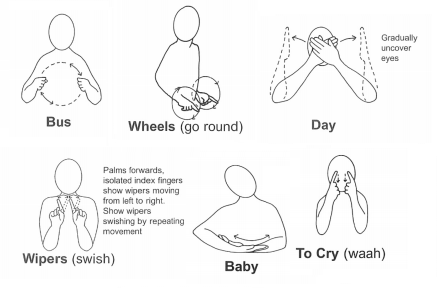Sign Along with Makaton
Create a multi-sensory experience for children by using Makaton signs along to your child’s favourite songs and rhymes.
In order to be able to sign along to your child’s favourite song/rhyme you will need to research some of the Makaton signs for key words beforehand. We have listed some useful sites at the bottom, have an example of what words to research, and have an example below for you to try.
• Facing your child, sing and sign along to your chosen song/rhyme. Facing your child and using lots of facial expressions and body language alongside the signs, helps to add the meaning of the words/signs. This also supports children’s attention throughout
• You won’t be able to sign every word, so during the song, emphasise the action words in the sentence. For example, if you chose “five little ducks went swimming one day”, you may just sign the number five and the words ducks and Speak/sing clearly at all times when signing, as Makaton is to be used alongside speech – not to replace it.
• Have fun! Remember to use lots of praise for any attempts of signs from your child, even if it’s not quite the right sign - learning signs takes time and practice!

The wheels on the bus go round and round,
round and round, round and round
The wheels on the bus go round and round
All day long…
The wipers on the bus go swish, swish, swish
swish, swish, swish, swish, swish, swish
The wipers on the bus go swish, swish, swish
All day long …
The babies on the bus go whoa, whoa, whoa,
whoa, whoa, whoa, whoa, whoa, whoa
The babies on the bus go whoa, whoa, whoa
All day long …
The activity:
If you’d like to learn a couple more, check out our videos for Jack and Jill and Pat-a-Cake
How this supports your child’s learning:
Learning Makaton signs and using these throughout everyday life can help children:
• Communicate their needs and feelings, and help them to feel understood, valued, and reassured that their thoughts and feelings are important
• Support children’s listening skills
• Develop their understanding of speech, and support their communication and language development. As Makaton signs often “look like” what they represent these extra visual clues help convey meaning.
Extending the activity:
Enjoy using Makaton with your child in everyday life. Puppets can be a great visual aid to extend an activity – you can use them to sing and sign and talk about emotions - teaching signs and symbols for “happy”, “sad”, “angry” and “scared.”
You can get more ideas for signs and songs/rhymes to learn together here: https://singinghands.co.uk/
Useful Resources
• https://www.bbc.co.uk/cbeebies/grownups/makaton
• https://www.bbc.co.uk/cbeebies/joinin/something-special-getting-started-with-makaton
• https://www.bbc.co.uk/cbeebies/watch/playlist-something-special-really-useful-makaton-signs
*Please note that this list is general signposting and is not a specific endorsement or recommendation by Bright Horizons. Should you utilise or download any of these resources, any exchange of data is solely between you and that provider – please note that these resources may be subject to their own terms and conditions and / or privacy notice. (As Bright Horizons has no control of the contents of the external resources, it can assume no responsibility or liability for these resources or the provider’s use of any data you share with them.)